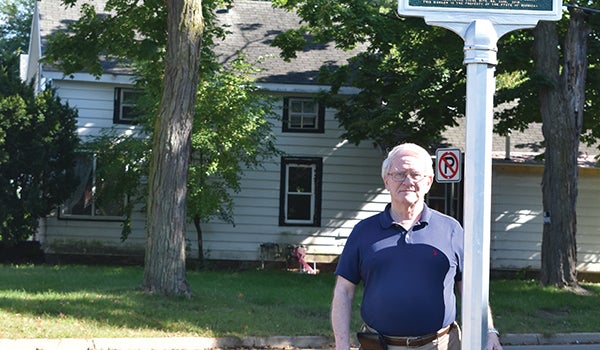Criffield-Whiteley House earns Michigan Historic Marker
Published 8:09 am Thursday, September 19, 2019
DOWAGIAC — Dowagiac resident Leon Anderson’s home has stood in the same place for the past 121 years, and its walls still hold the stories and memories of past owners who made contributions in the city of Dowagiac and beyond.
Now, Anderson has made his own mark on the Criffield-Whiteley House in Dowagiac. The home, which was added to the National Register of Historic Places in 2016, recently was accepted as a Michigan Historic Site after a two-and-a-half-year process. The house has a marker and is listed on the National Register of Historic Places in Michigan.
At 2 p.m. on Sept. 24 a marker dedication ceremony will be hosted at the Criffield-Whiteley House, where Anderson will share stories and unveil the marker alongside representatives from the organizations that past home owners were involved in.
“Basically, you submit documentation for everything you can find, which was easy because we had already had all the documents,” Anderson said regarding the process of the home becoming on the state register.
The Queen Anne style home was built by businessman and farmer, Charles Criffield, and his wife, Cora, in 1897. Fred Corber managed the construction of the home.
In 1920, the Criffields sold the home to Ethel and Harry Whiteley. Harry was later elected to the House of Representatives for a short term in 1914. A year later, the Whiteleys moved to Dowagiac in 1915, so Harry could buy and manage the Dowagiac Daily News. Through Harry’s ownership of the Dowagiac Daily News, his position on the Michigan Senate for three years and position on the Michigan Conservation Commission for 21 years, he played a key role in shaping Michigan’s public land policy. Among Harry’s positions, he advocated for public parklands, managing game populations while protecting habitat and made contributions to natural resource conservation.
Ethel was instrumental in her own way as a founding member of the Captain Samuel Felt Chapter of the Daughters of the American Revolution. She led the chapter’s efforts to honor World War II veterans with a memorial highway and park in Cass County.
In 1960, the home was sold to Leroy and Martha Cox, who owned the home for 21 years before they decided to sell it to the Andersons, who had moved back to Dowagiac in 1977. The couple had a son, were pregnant with another child, and decided to rent an apartment in Indian Hills.
“We started looking for houses. We wanted a house like this,” Anderson said motioning to the historic home standing next to him. “Every house we wanted, we couldn’t afford. Every house we could afford, we didn’t want.”
The couple bought a fixer-upper cheap on Prairie Ronde Road and started working on it. Martha, at the time, worked at the school administration building as a secretary, and Leon expressed interest in her home. In 1981, the Coxes decided to sell the historic home. At the time, interest rates were low, and Leroy, who was a banker, worked out the kinks so both the Coxes and Andersons could end up in the homes they desired. During the Andersons’ time in the home, they raised three sons.
“That’s how we got in, and I’ve been here ever since,” Anderson said.
While the outside appearance of the home looks nearly identical to earlier photographs, much of the inside has also maintained its historical integrity. The Andersons used seven different reproduction wallpapers from the period, and during renovations in 1999, had a display box cut into drywall to display a large set of initials, “AW,” that belonged to Arthur Whiteley, son of Harry and Ethel Whiteley.
Anderson said he gives the Coxes the most credit for why the house is still the same today.
“The Coxes really deserve a lot of credit because they owned the house in the ‘60s and ‘70s when people were converting these houses into apartments,” Anderson said. “They were tearing porches off, changing windows, and they never did that.”
Stories from the home span generations, but for Anderson, a lesson learned one Christmas is what he remembers the most. Christmas was a huge deal for his wife, Jane, who died in May of last year.
“She decorated every room in this house for Christmas,” Anderson said. “Every year in the tower, we always put a live Christmas tree that was 9-feet-tall and 9-feet across.”
The first year the couple put a tree up, they decorated the one side with ornaments, glass ice cycles and candles, but had decorated the tree in position.
“We were so proud of how it looked,” Anderson said “The next day, the tree fell over.”
Jane, who Anderson said was only about 5-feet tall, picked the tree up, and the couple wrapped a piece of wire around the trunk and attached it to little locks in the windows to ensure that it would not fall down.
In the 80s and early 90s, the couple also showed their home as part of Dowagiac’s historical home tours.
Small items have been added onto the lot of the house, like a fountain Anderson acquired at a garage sale for $5. Now, the memories of past owners stay encapsulated by a new addition to the property’s front yard.
Leading up to the marker sits a path of bricks — five of which are engraved with the names of each of the owners of the house. One brick reads Leon “Andy” and Jane Anderson, 1981-2019. This brick leads onto the next set of names, Matthew and Allexia Money, 2019.
Anderson’s decision to sell his home was not easy, but he knew the Criffield-Whiteley House was going to people who wanted it.
Anderson said the house has always been passed down to someone who the previous owners felt was going to keep things the same.
“I understand from Mrs. Cox, when they bought the house from Mrs. Whiteley, that one of the reasons Mrs. Whitely sold the house to the Coxes is because they didn’t want to change things,” Anderson said. “I’ve got a feeling the Criffields were probably somewhat the same way.”
After Anderson’s experience with applying for a Michigan Historical Site marker was positive, he would like to encourage more people to do the same, not only with their homes, but also with buildings in the area.
“What a good way to tell Dowagiac’s story by its history,” Anderson said.







